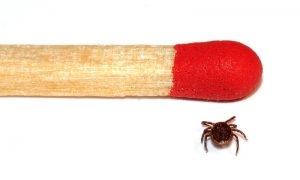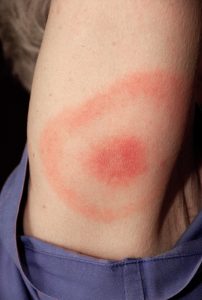Everything about Lyme disease: diagnosis, treatment, infection, symptoms
The beginning of spring is also the start of the tick season. These flat spider-like animals – no more than 1 to 3 millimeters – live low in the ground in high grass and bushes: not only in dunes, forests and meadows, but also in parks, plants and gardens. From their low position, they can easily grab people and animals. A bite of a tick can lead to Lyme disease. This is a multi-system disease. Thus, this group of disorders affects multiple body functions and organs at the same time. Lyme disease can also show rheumatic manifestations on the muscles and joints.
Why do ticks bite?
During their life, ticks must feed three times. The first meal they need to develop from larva to nymph. The next dose of blood helps them to grow from nymph to mature. The last time the tick bites is to lay eggs. Every time, the insect takes three to seven days to drink the blood. Once filled with blood, the tick falls to the ground. It will take a few months before it tries to find more prey to ambush.
Why is a tick bite dangerous?
In the United States, ticks infected with Borrelia burgdorferi bacterium range from 0% to 70% depending on location. We also call this the Lyme bacterium because it causes Lyme disease. Ticks pick up these pathogens when they suck the blood of small rodents and birds carrying this bacterium. When a tick bites you, the infection with the Lyme bacterium does not happen at once. If you remove the tick within 24 hours, the chance of Lyme disease is very small. Then the risk becomes greater.
What are the symptoms of a tick bite?
Lyme disease is a bacterial infectious disease. The first signal of this disorder is a red, annular rash that develops around the drawing bite.
This circle is known as erythema migrans. This circle or stain appears within 2 to 14 days after the bite of the infected tick. Sometimes it may take 3 months. Eventually the erythema migrans will disappear again, but chances are that the bacterium still is in the body, which requires antibiotics. When you do not notice the tick bite, or do not start treatment on time, a variety of health problems may occur. The bacterium mainly affects the nerves, joints, skin and sometimes the heart. The symptoms may differ from person to person. It may be fatigue, flu-like symptoms, muscle and joint pain, amnesia and concentration disorders. In the Netherlands, Lyme disease is usually associated with nervous system disorders such as nerve pain or nerve failure. This may lead to, for example, paralysis of the facial muscles or pain in the legs and arms.
In addition, people infected with Lyme bacterial joint inflammations, skin disorders and sometimes also get heart rhythm disorders. By the way, many people get Lyme disease without the appearance of a red circle on the skin after a tick bite. Therefore, it is important to always stay alert after a tick bite. After the first vague symptoms, go to the GP directly.
What is Lyme late or chronic disease?
It may be possible that after a bite of a contagious tick you have no problems at all in the first year. Only after that, skin complaints and joint inflammations usually occur. We call this late or chronic Lyme disease.
The skin of the arms or legs may turn red to purple and feels warm. We call this phenomenon acrodermatitis chronica atrophicans or Pick-Herxheimer’s disease. At a later stage, the skin may become as thin as paper. Chronic Lyme disease can also cause joint inflammation, heart and eye problems and nerve failure.
The late variant of Lyme disease is a nasty and progressive disorder. When bitten by a tick, it is therefore wise to always be aware. If Lyme disease only becomes manifest after a long time it helps the doctor to diagnose the disease.
How do you diagnose Lyme disease?
The GP can easily diagnose Lyme when he sees the red circle around the tick bite. In that case a blood test is not necessary. If there is no circle around the bite site, then your GP may have your blood checked for the presence of two types of antibodies against the Borrelia burgdorferi bacterium. It is important that you go to your GP if you get health problems within three months after a tick bite.
How do you treat Lyme disease?
If your doctor diagnoses you with Lyme disease, your doctor will prescribe antibiotics. Such a treatment cure lasts ten days to four weeks. In most cases, the problems resolve or disappear completely. The sooner the treatment begins after a tick bite, the better the drugs work. If you also experience disorders of the nerves, joints, eyes or heart, with Lyme disease you will your doctor will recommend a specialist. This referral usually takes place in late or chronic Lyme disease.
How to prevent a tick bite?
Due to climate change, ticks may now be active throughout the year. Therefore, ensure that your body is well covered when going out to the dunes, fields and forests. Wear light clothing so that the tick is clearly visible, also while gardening. As many as 30 percent of people get a tick bite in their own garden. Wear a cap or a hat, stay on the trails and do not walk through bushes and plants. You can always wipe your skin with an insect repellent. Check your clothing and body carefully when you have been in a green area.
How to remove a tick?
On this page you will find extensive information about removing ticks:
https://www.webmd.com/first-aid/tc/how-to-remove-a-tick-overview#1

Share this page
Tweet

Download for free the booklet ‘Moving without pain’ with a retail value of $6.75 / £4.95.
Any questions? Please feel free to contact us. Contact us.







